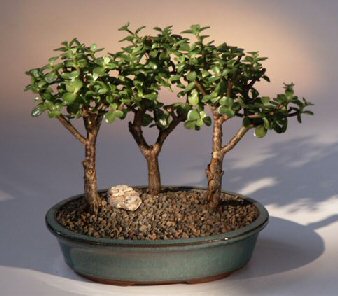(portulacaria afra)
Baby Jade-3 Bonsai Tree Group
(portulacaria afra)
- Features:
- 3 tree group, each 4-5 years old, 9" tall
- Recommended bonsai tree, grown and trained by Bonsai Boy
- Suitable humidity/drip tray is recommended. To purchase add 9.95
Baby Jade-3 Bonsai Tree Group
(portulacaria afra)
Many people believe that bonsai is a special breed of dwarf trees. In
fact, every bonsai is a common tree in a pot, which is cut, the cable
and re-poured with care during their life will grow into a specific
shape and size desired. You can create a bonsai tree for many species - maple and juniper evergreens and boxwood.The tradition of bonsai is all about imitating nature. Bonsai are made on the basis of appearance, of course, in the forest or other natural environment. To produce its forms, bonsai gardeners use wire to train every part of the tree, bending the branches into place. Branches, stems, roots and shoots are pruned on a regular basis.When considering the style of bonsai tree you want to grow, think of the natural characteristics of each species. It is much easier to train the tree to grow as we could find in nature.There are several classic bonsai styles that have existed for centuries. The formal upright style, the trunk is vertical and meets up front, or directly on the hull. The branches, which are often grouped in threes, then they are arranged symmetrically and evenly spaced on both sides form a pyramidal shape. This style suits coniferous species such as larch, juniper, pine, fir, cypress cypress (Japanese) and cedar (Japanese cedar).Informal upright shape is similar to the formal style, but the tribe is allowed to curve, as would be tilted towards the sun. Many species are adapted to this style, including Japanese maples, such as maple, beech, pine and pine and white pine.Oblique style mimics the tree, which deviated from the wind, torso tilted to one side, either smooth or abrupt, with branches arranged on both sides. Most species are adapted to this style, but especially conifers.Cascading style bonsai trees, whose branches and drop points lower than at the edge of their packaging, sometimes all the way to the base. The main trunk of a cascade bonsai is often twisted and bent like curve running down the slope. Species such as cherry blossoms work well in cascading style sheets, and so do pine and cedar and Japanese cedar.Broom style bonsai is a tree with upright branches that sprout angles that give symmetry, broom-shaped appearance elms are often well suited for this style.In addition to simple bonsai trees planted in individual containers, bonsai artists sometimes two or more trees, together with a double trunk style to create a unique look and illusion provide forest environment is very small. If you are planting more than one tree, select species that look good together and their sizes and shapes complement each other. In Japanese tradition, there are three trees that have grown together to symbolize the sun, moon and earth, father, mother and son, or heaven, earth and man. Species which seeks to include this style of Japanese beech and maple.
Buy Baby Jade-3 Bonsai Tree Group
(portulacaria afra)


No comments:
Post a Comment